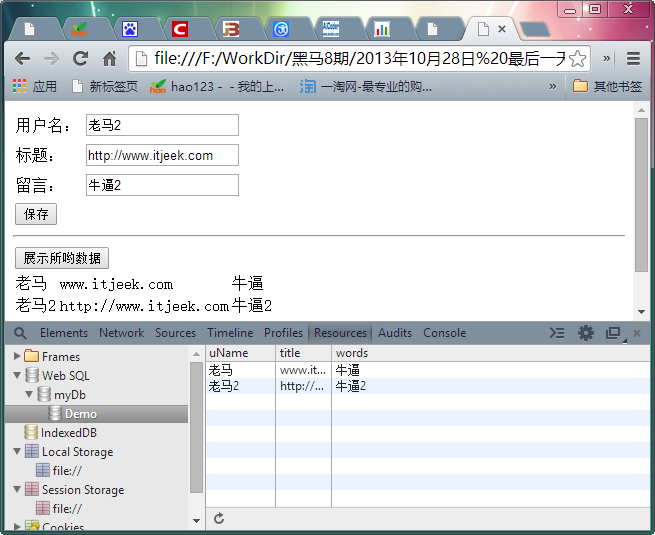
Local database is a new feature of html5. Html5 provides a browser-side database support, allowing developers to create a local database on the browser side directly through the JS API, and supports standard SQL CRUD operations, making offline web applications more convenient to store structured data. .

The operating environment of this tutorial: Windows 7 system, HTML5 version, Dell G3 computer.
Although Html5 has provided powerful localStorage and sessionStorage, both of them can only provide data for storing simple data structures, and are powerless for complex web application data. What’s incredible is that Html5 provides a database support on the browser side, allowing us to create a local database on the browser side directly through the JS API, and supports standard SQL CRUD operations, making offline web applications more convenient to store structures. ized data. Next, we will introduce the relevant APIs and usage of local data.
The most basic steps to operate a local database are:
Next, we will introduce the parameters and usage of the relevant methods.
(1) openDatabase method:
//Demo:获取或者创建一个数据库,如果数据库不存在那么创建之
var dataBase = openDatabase("student", "1.0", "学生表", 1024 * 1024, function () { });The openDatabase method opens an existing database. If the database does not exist, it can also create a database. The meanings of several parameters are:
(2) The db.transaction method can set a callback function. This function can accept a parameter that is the object of the transaction we started. Then the Sql script can be executed through this object, which can be combined with the following steps.
(3) Execute the query through the executeSql method.
ts.executeSql(sqlQuery,[value1,value2..],dataHandler,errorHandler)
Parameter description:
The following It is a comprehensive example, you can take a look:
<head>
<script src="Scripts/jquery-1.5.1.js" type="text/javascript"></script>
<script type="text/javascript">
function initDatabase() {
var db = getCurrentDb();//初始化数据库
if(!db) {alert("您的浏览器不支持HTML5本地数据库");return;}
db.transaction(function (trans) {//启动一个事务,并设置回调函数
//执行创建表的Sql脚本
trans.executeSql("create table if not exists Demo(uName text null,title text null,words text null)", [], function (trans, result) {
}, function (trans, message) {//消息的回调函数alert(message);});
}, function (trans, result) {
}, function (trans, message) {
});
}
$(function () {//页面加载完成后绑定页面按钮的点击事件
initDatabase();
$("#btnSave").click(function () {
var txtName = $("#txtName").val();
var txtTitle = $("#txtTitle").val();
var txtWords = $("#txtWords").val();
var db = getCurrentDb();
//执行sql脚本,插入数据
db.transaction(function (trans) {
trans.executeSql("insert into Demo(uName,title,words) values(?,?,?) ", [txtName, txtTitle, txtWords], function (ts, data) {
}, function (ts, message) {
alert(message);
});
});
showAllTheData();
});
});
function getCurrentDb() {
//打开数据库,或者直接连接数据库参数:数据库名称,版本,概述,大小
//如果数据库不存在那么创建之
var db = openDatabase("myDb", "1.0", "it's to save demo data!", 1024 * 1024); ;
return db;
}
//显示所有数据库中的数据到页面上去
function showAllTheData() {
$("#tblData").empty();
var db = getCurrentDb();
db.transaction(function (trans) {
trans.executeSql("select * from Demo ", [], function (ts, data) {
if (data) {
for (var i = 0; i < data.rows.length; i++) {
appendDataToTable(data.rows.item(i));//获取某行数据的json对象
}
}
}, function (ts, message) {alert(message);var tst = message;});
});
}
function appendDataToTable(data) {//将数据展示到表格里面
//uName,title,words
var txtName = data.uName;
var txtTitle = data.title;
var words = data.words;
var strHtml = "";
strHtml += "<tr>";
strHtml += "<td>"+txtName+"</td>";
strHtml += "<td>" + txtTitle + "</td>";
strHtml += "<td>" + words + "</td>";
strHtml += "</tr>";
$("#tblData").append(strHtml);
}
</script>
</head>
<body>
<table>
<tr>
<td>用户名:</td>
<td><input type="text" name="txtName" id="txtName" required/></td>
</tr>
<tr>
<td>标题:</td>
<td><input type="text" name="txtTitle" id="txtTitle" required/></td>
</tr>
<tr>
<td>留言:</td>
<td><input type="text" name="txtWords" id="txtWords" required/></td>
</tr>
</table>
<input type="button" value="保存" id="btnSave"/>
<hr/>
<input type="button" value="展示所哟数据" onclick="showAllTheData();"/>
<table id="tblData">
</table>
</body>
</html>The execution effect is as shown in the figure:

Related recommendations: "html video Tutorial》
The above is the detailed content of Is local database a new feature of HTML5?. For more information, please follow other related articles on the PHP Chinese website!
 How to solve the problem of missing ssleay32.dll
How to solve the problem of missing ssleay32.dll
 How to open the terminal window in vscode
How to open the terminal window in vscode
 Is A5 bigger or B5 paper bigger?
Is A5 bigger or B5 paper bigger?
 The role of parseint function
The role of parseint function
 The difference between arrow functions and ordinary functions
The difference between arrow functions and ordinary functions
 How to define an array
How to define an array
 How much is Snapdragon 8gen2 equivalent to Apple?
How much is Snapdragon 8gen2 equivalent to Apple?
 fil currency price real-time price
fil currency price real-time price
 SpringBoot project building steps
SpringBoot project building steps